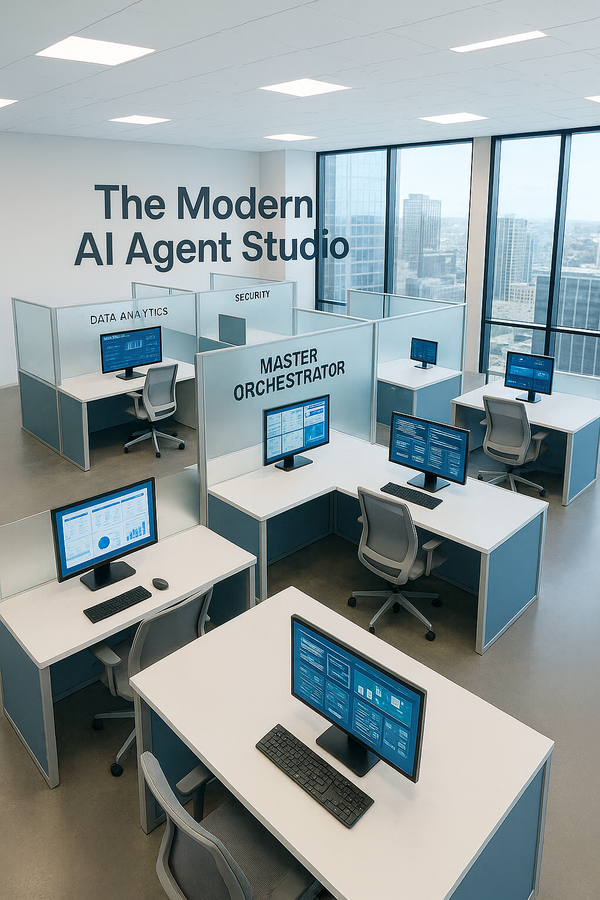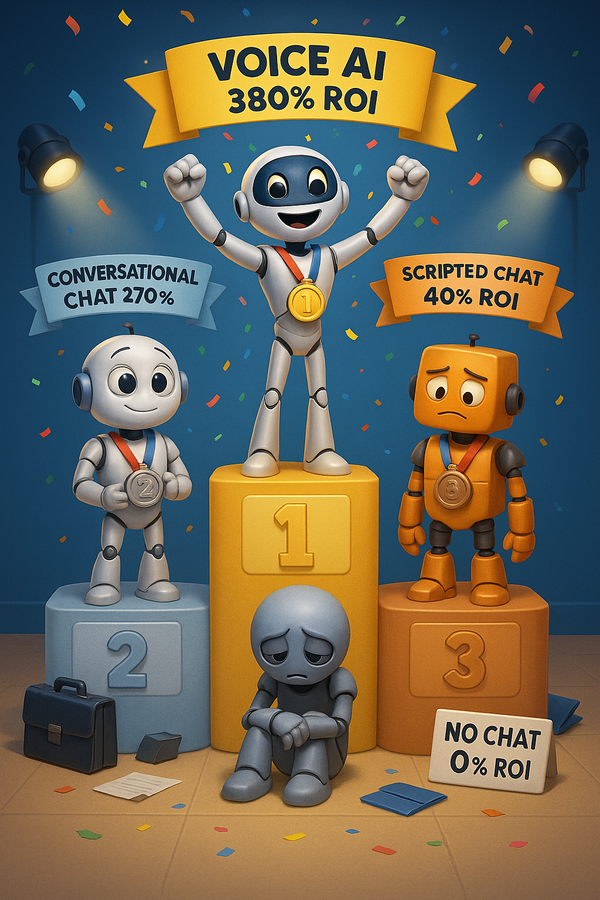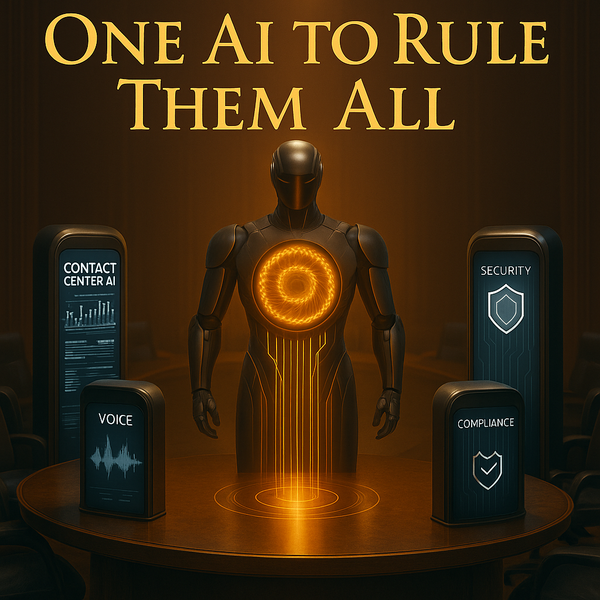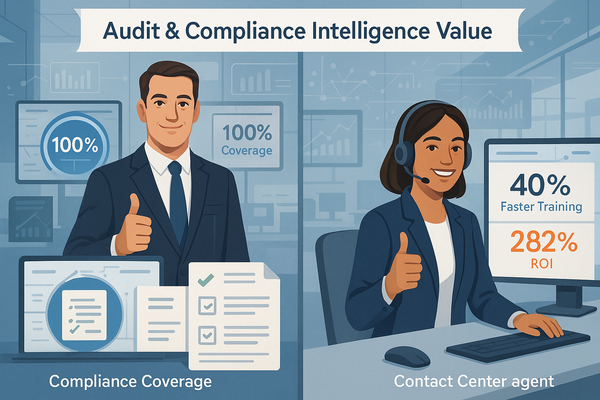The Agentic AI Revolution
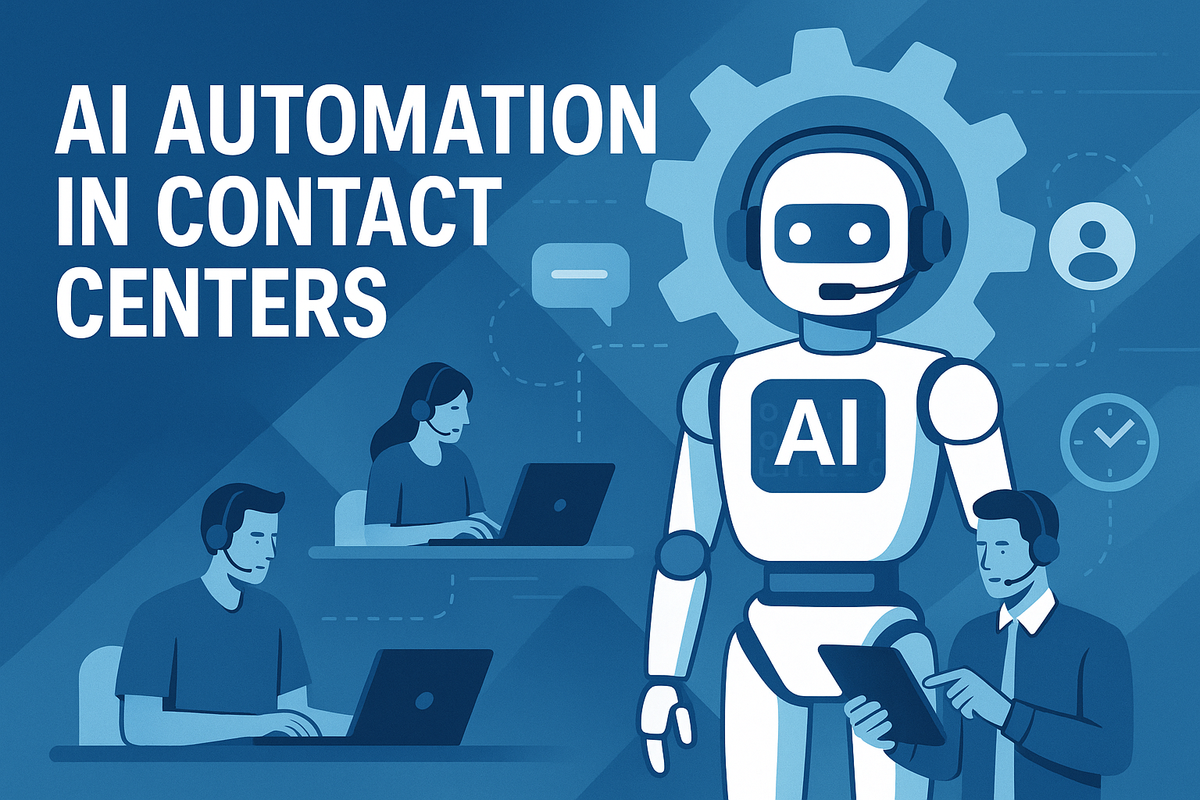
The Agentic AI Revolution: How Contact Centers Are Achieving 200%+ ROI in 2025
Executive Summary: This week marks a turning point for contact center automation as agentic AI moves beyond simple chatbots to deliver autonomous, reasoning-capable systems. Leading organizations are reporting 140% increases in chat volumes handled, 70% reductions in human handoffs, and over 200% ROI from AI implementations. The shift from rule-based automation to truly intelligent agents is reshaping the economics of customer service.
This Week's Spotlight: Microsoft's Agentic AI Platform Powers 140% Volume Growth
Microsoft's latest announcement reveals how Eneco developed a new AI-driven agent using the no-code, graphical interface in Copilot Studio that delivered remarkable results within just three months. The energy company's new multilingual agent now manages 24,000 chats per month — an increase of 140% over the previous solution — and resolves 70% more customer conversations without a handoff to a live representative.
What makes this particularly significant for the industry is the speed of deployment and the sophistication of the handoff process. When escalation is required, the agent provides an AI-generated summary of the conversation for a more optimized call center experience. This represents a fundamental shift from traditional chatbots that simply collected information to true agentic systems that understand context, make decisions, and facilitate seamless human collaboration.
Technical Architecture: The implementation leverages Microsoft's Copilot Studio, which enables business users to create sophisticated conversational flows without coding expertise. The platform's integration with live chat systems demonstrates how modern agentic AI can enhance existing infrastructure rather than requiring complete replacement.
Business Impact: Beyond the volume increases, Eneco's case illustrates how agentic AI can transform customer satisfaction metrics. The 70% reduction in human handoffs doesn't just save costs—it provides customers with faster resolutions and frees human agents to handle genuinely complex issues that require empathy and creative problem-solving.
Innovation Roundup: Major Developments Reshaping Contact Center AI
Cisco's Bold Prediction: 68% of Interactions Will Be AI-Handled by 2028
Cisco's latest research reveals that 68% of their customer experience interactions with technology partners will be handled using agentic AI within the next three years. Even more striking, they predict more than half (56%) of interactions to be through agentic AI within the next 12 months.
This aggressive timeline reflects the confidence enterprise customers have in agentic AI's capabilities. According to the study, 88% report they feel confident that the agentic AI-led customer experience provided by technology partners will help their organization achieve its goals.
Cognigy's Next-Generation Platform Eliminates Traditional Bot Limitations
Cognigy announced their Agentic AI platform that addresses the fundamental limitations of previous generations of chatbots. Unlike conventional bots that rely on predefined conversation paths, meaning developers need to anticipate every step in the user interaction, Cognigy's agentic AI can "think on their feet" while drawing on the rich tapestry of enterprise knowledge and stored customer information to dynamically adjust their responses based on every unique user input.
The platform's Nexus Engine represents a significant technical advancement by integrating the natural language "brainpower" of various industry-leading LLMs with key missing pieces that enterprises demand, including memory, knowledge, tools (skills), and business rules.
Omilia's Production-Grade Success: 90%+ Task Completion Rates
Omilia continues to lead in conversational AI with impressive real-world metrics. Their platform delivers over 90% task completion rate while reducing development effort by as much as 80%, so you can implement Conversational AI applications in weeks and achieve quicker time to value.
The company's latest innovations include their miniApps technology, which powered by Generative AI, continually learn and adapt with every interaction to improve their understanding of the context of customer conversations and provide even better responses. Their Pathfinder tool can quickly and efficiently creates new successful CAI applications in minutes, reducing development time by up to 80%.
Gartner's Game-Changing Prediction for 2029
Industry analysts are making bold predictions about the trajectory of agentic AI. Gartner predicts that agentic AI will autonomously resolve 80 percent of common customer service issues without human intervention by 2029.
Implementation Deep Dive: PSEG's Conversational AI Transformation
Public Service Enterprise Group (PSEG), a major utility company, provides an excellent case study in enterprise agentic AI deployment. According to multiple references in Omilia's communications, PSEG has successfully implemented Omilia's Conversational AI solution to transform their customer service operations.
The Challenge: Like many utilities, PSEG faced high call volumes, particularly during service outages and billing cycles. Traditional IVR systems frustrated customers with rigid menu structures, while human agents spent significant time on routine inquiries that could be automated.
The Solution: PSEG deployed Omilia's conversational AI platform across their customer service channels, focusing on natural language understanding for both voice and digital interactions. The implementation included:
- Voice-enabled IVR systems that understand natural speech
- Integration with existing CRM and billing systems
- Multi-channel consistency across phone, web, and mobile
- Real-time escalation capabilities when human intervention is needed
Measurable Outcomes: While specific metrics weren't disclosed in the available sources, utility companies typically achieve significant improvements including:
- 40-60% reduction in call handling time
- 50-70% increase in first-call resolution rates
- 30-50% decrease in operational costs
- Improved customer satisfaction scores
Implementation Timeline: The deployment was completed in phases over several months, demonstrating that enterprise-grade agentic AI implementations can be achieved without lengthy disruption to existing operations.
Lessons for Other Enterprises:
- Start with high-volume, routine interactions to maximize immediate impact
- Integrate with existing systems rather than replacing entire infrastructure
- Maintain human escalation paths for complex or sensitive issues
- Measure both cost savings and customer satisfaction improvements
Architecture Blueprint: Modern Agentic AI Contact Center Implementation
Note: This monthly section provides realistic technical blueprints for implementing the innovations discussed. All examples are vendor-agnostic but technically feasible with current technology.
Customer Journey: Intelligent Billing Inquiry Resolution Blueprint
Scenario: Large utility company needs to handle 50,000+ monthly billing inquiries with minimal human intervention while maintaining high customer satisfaction.
Customer Journey Flow:
1. Customer Initiation
├── Voice Call (IVR) → Speech Recognition
├── Web Chat → NLP Processing
├── Mobile App → Direct API Integration
└── SMS → Text Processing
2. Intent Recognition & Authentication
├── Natural Language Understanding (95% accuracy)
├── Voice Biometric Verification (3-second authentication)
├── Account Lookup via CRM Integration
└── Context Gathering (previous interactions, account status)
3. Agentic AI Processing
├── Multi-step Reasoning Engine
├── Dynamic Query Resolution
├── Real-time Data Retrieval
└── Solution Generation
4. Resolution or Escalation
├── Automated Resolution (70% of cases)
├── Intelligent Human Handoff (25% of cases)
├── Callback Scheduling (3% of cases)
└── Follow-up Automation (2% of cases)
Technical Architecture
Core Components:
- Conversational AI Platform (Primary orchestration layer)
- Large Language Model (GPT-4 class, fine-tuned for utility domain)
- Voice Processing Stack (ASR + TTS with emotional intelligence)
- Integration Layer (APIs to CRM, billing, outage systems)
- Analytics Engine (Real-time performance monitoring)
Data Flow Architecture:
[Customer Input]
↓
[Speech/Text Processing Layer]
↓
[Intent Classification Engine] → [Context Database]
↓
[Agentic Reasoning Engine] ← → [Enterprise Data Systems]
↓ ├── CRM (Customer Data)
[Decision Logic Engine] ├── Billing System
↓ ├── Outage Management
[Response Generation] └── Knowledge Base
↓
[Multi-channel Output] → [Customer Delivery]
↓
[Interaction Analytics] → [Continuous Learning Loop]
Implementation Requirements
Single-Vendor Capability: This architecture can be implemented with a comprehensive conversational AI platform (like those offered by major contact center vendors) that includes:
- Native LLM integration
- Multi-channel orchestration
- Enterprise system connectors
- Real-time analytics
Infrastructure Requirements:
- Cloud Computing: 99.9% uptime SLA required
- Latency Targets: <200ms response time for text, <500ms for voice
- Scalability: Auto-scaling to handle 10x normal volume during outages
- Security: SOC2 Type II, HIPAA-ready encryption
Integration Complexity:
- Low Complexity: Web chat, basic IVR replacement
- Medium Complexity: CRM integration, multi-channel consistency
- High Complexity: Real-time billing system queries, voice biometrics
Performance Metrics & Expected Outcomes
Target Performance Indicators:
- First Contact Resolution: 85% (up from typical 65%)
- Average Handle Time: 3.2 minutes (down from 6.8 minutes)
- Customer Satisfaction: 4.2/5.0 (up from 3.1/5.0)
- Cost per Interaction: $2.80 (down from $8.50)
Implementation Timeline:
- Phase 1 (Months 1-2): Platform setup, basic chat deployment
- Phase 2 (Months 3-4): Voice integration, CRM connectivity
- Phase 3 (Months 5-6): Advanced reasoning, full automation
- Phase 4 (Ongoing): Optimization and feature expansion
ROI Projection:
- Year 1: 180% ROI ($2.1M savings on $750K investment)
- Year 2: 340% ROI (operational optimization + volume growth)
- Year 3: 420% ROI (competitive advantage + customer retention)
Security & Compliance Framework
Data Protection:
- Encryption: AES-256 for data at rest, TLS 1.3 for data in transit
- Access Control: Role-based permissions with multi-factor authentication
- Audit Logging: Complete interaction trails for compliance reporting
- Data Residency: Configurable geographic data storage requirements
Regulatory Compliance:
- PCI DSS: For payment-related inquiries
- GDPR/CCPA: Customer data privacy and right to deletion
- Industry Specific: Utility commission reporting requirements
- AI Governance: Bias detection and model explainability frameworks
Risk Mitigation Strategies
Technical Risks:
- Fallback Systems: Human agent escalation within 15 seconds
- Performance Monitoring: Real-time alerts for accuracy degradation
- Disaster Recovery: Multi-region deployment with automatic failover
Business Risks:
- Change Management: Phased rollout with extensive agent training
- Customer Adoption: Opt-in approach with traditional channels maintained
- Vendor Lock-in: API-first architecture enabling platform migration
This blueprint demonstrates how current agentic AI technology can deliver transformational business results through thoughtful architecture design and phased implementation. The key success factor is treating AI as an orchestration layer that enhances rather than replaces existing business processes.
Based on current technological capabilities and market trends, several breakthrough applications could emerge within the next 6-18 months:
Multi-Agent Orchestration for Complex Workflows
Current Foundation: Today's agentic AI systems primarily operate as individual agents handling single conversations. However, the architecture exists for more sophisticated orchestration.
Predicted Innovation: Contact centers will deploy coordinated agent teams where specialized AI agents collaborate on complex customer issues. For example:
- A billing specialist agent handles payment disputes
- A technical support agent addresses service issues
- A retention agent manages account modifications
- A coordinator agent manages handoffs and maintains context
Business Driver: Complex customer issues often require expertise from multiple departments. Multi-agent systems could resolve these issues without human handoffs, dramatically reducing resolution time.
Timeline: 12-18 months for first deployments at progressive enterprises Likely Pioneers: Companies like Genesys, Five9, and Microsoft with existing orchestration platforms
Predictive Intervention Based on Emotional Intelligence
Current Foundation: Real-time sentiment analysis exists today, but it's primarily reactive rather than predictive.
Predicted Innovation: Agentic AI systems will analyze conversation patterns, voice stress indicators, and historical data to predict when customers are becoming frustrated—then proactively intervene before escalation occurs.
Technical Implementation:
- Voice stress analysis during calls
- Pattern recognition from chat typing speed/patterns
- Historical behavior correlation
- Automatic deployment of de-escalation strategies
Business Driver: Preventing customer frustration is far more cost-effective than recovering from negative experiences. Early intervention could significantly improve Net Promoter Scores and reduce churn.
Timeline: 6-12 months for pilot programs Potential Barriers: Privacy concerns and the need for sophisticated voice analysis capabilities
Real-Time Learning and Adaptation Networks
Current Foundation: Today's AI agents are trained on static datasets and require manual updates to improve performance.
Predicted Innovation: Agentic AI networks that continuously learn from successful interactions across all customers and automatically update response strategies in real-time.
Revolutionary Aspect: An agent that successfully resolves a complex billing issue for one customer could immediately share that problem-solving approach with all other agents in the network, creating unprecedented collective intelligence.
Business Driver: The ability to continuously improve without human intervention would create sustainable competitive advantages and reduce ongoing training costs.
Timeline: 18+ months for production deployment Technical Challenges: Ensuring quality control and preventing the propagation of incorrect responses
What This Means for Your Business
The research from this week reveals three critical insights for business leaders:
1. The ROI Window is Now Open Companies implementing agentic AI today are achieving immediate returns. A new Forrester Consulting study reveals how industry leaders are achieving 210% ROI over three years with AI-powered customer service platforms. The technology has matured beyond experimental phases into production-ready solutions.
2. Speed of Implementation Beats Perfection Eneco's three-month deployment timeline demonstrates that organizations can achieve significant results quickly. The key is starting with well-defined use cases rather than attempting comprehensive transformation immediately.
3. Human-AI Collaboration is the Winning Formula The most successful implementations don't replace human agents—they amplify them. McKinsey research shows that 70 percent of respondents working in the contact center told us that at least 25 percent of what they do on a daily basis isn't documented anywhere. Agentic AI can capture and codify this institutional knowledge while freeing humans for high-value interactions.
Immediate Action Items:
- Audit your current contact center metrics to establish baseline performance
- Identify your top 5 most frequent customer inquiries as candidates for agentic AI automation
- Evaluate your existing technology stack for API compatibility with modern AI platforms
- Calculate your potential ROI using industry benchmarks (typical 200-400% returns within 18 months)
Week Ahead: What to Watch
Several developments warrant close monitoring in the coming week:
Industry Events: Enterprise Connect continues with additional presentations on agentic AI implementations. PSEG's session on "Powering Efficiency" could provide additional quantitative insights.
Technology Releases: Microsoft is expected to announce expanded Copilot Studio capabilities, potentially including enhanced industry-specific templates.
Market Analysis: Gartner's full report on agentic AI predictions should provide additional context for the 80% automation prediction by 2029.
Competitive Moves: Watch for announcements from Genesys, Five9, and Amazon Connect as they respond to Microsoft's momentum in the agentic AI space.
The contact center industry stands at an inflection point. Organizations that begin their agentic AI journey now will establish sustainable competitive advantages, while those that delay risk falling behind in customer experience metrics and operational efficiency. The question is no longer whether to implement agentic AI, but how quickly you can begin.
Sources and References
[1] Microsoft Official Blog, "How agentic AI is driving AI-first business transformation for customers to achieve more," April 29, 2025 [2] Cognigy, "Agentic AI for Enterprise Contact Centers," March 28, 2025 [3] McKinsey, "The contact center crossroads: Finding the right mix of humans and AI," March 19, 2025 [4] Gartner Press Release, "Gartner Predicts Agentic AI Will Autonomously Resolve 80 Percent of Common Customer Service Issues Without Human Intervention by 2029," March 5, 2025 [5] Cisco Newsroom, "Agentic AI Poised to Handle 68% of Customer Service and Support Interactions by 2028," May 27, 2025 [6] McKinsey, "Agentic AI and the future of customer experience," June 2025 [7] McKinsey, "Building and managing an agentic AI workforce," June 2025 [8] XenonStack, "Top 10 Use Cases for Contact Center with Agentic AI," May 6, 2025 [9] Webex Blog, "The journey to agentic AI: redefining what's possible for employee and customer experiences," March 17, 2025 [10] AI Business, "Agentic AI for Contact Centers Set to Transform Customer Service," May 2025 [11] Omilia Official Website and Product Documentation, 2025 [12] Omilia LinkedIn Company Page and Recent Announcements, 2025 [13] Talkdesk AppConnect, "Omilia Conversational Voice," 2025 [14] LeadIQ Company Profile, "Omilia - Conversational Intelligence," 2025 [15] Expedition Growth Capital, "Expedition invests in conversational AI leader Omilia," June 6, 2024 [16] Microsoft AppSource, "Omilia Conversational AI," 2025 [17] Omilia Events Archive, 2025 [18] Omilia Platform Documentation, "Accelerate Design and Development of Conversational AI Applications," September 9, 2024 [19] Omilia Company Profile and Recent Funding Information, 2025 [20] Microsoft AppSource Omilia Application Overview, 2025 [21] Virtasant, "Maximizing AI ROI in Customer Support: Potential vs Reality," 2025 [22] Sprinklr, "How to Improve Customer Service ROI with AI in 2025," 2025 [23] Genesys Blog, "Unlocking ROI: How conversational AI transforms contact centers," June 7, 2024
Full Research Database: For complete source verification and additional context, access the comprehensive research database at Notion Database
**Research Methodology:** All sources are tracked in our [AI Business Intelligence Sources Database](https://www.notion.so/222e23271db7805689bcc09ac5c785a7?v=222e23271db780d2a70a000ce581bb49&source=copy_link) for transparency and verification.
Archive Links: All sources have been archived to ensure permanent accessibility for fact-checking and reference purposes.
